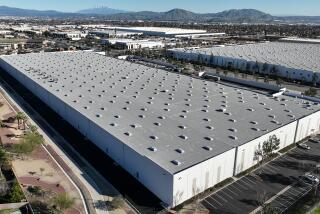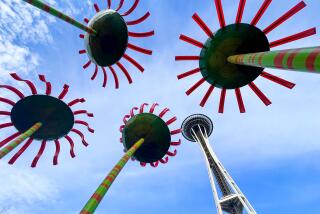Seattle debates adding corporate signs to skyline
- Share via
Reporting from Seattle — As urban skylines go, few are more striking than Seattle’s sharp, clean panorama of skyscrapers looming above the waterfront, the snowy peaks of the Cascade Mountains in the background.
Starting next year, visitors may quickly become aware that the tall building near the center of the tableau is the corporate headquarters of Russell Investments — a coup for the city’s economic development team and a kick in the stomach to the legions of urban design aficionados who have long worked overtime to fashion Seattle as the gold standard for liberal urban cool.
A new sign ordinance under review would pave the way for Seattle to join numerous cities around the world — Los Angeles, London, Pittsburgh and Detroit among them — that allow large company signs atop their loftiest buildings.
The idea of corporate fashion statements atop a stunning downtown skyline that many here see as an integral part of the city’s hipper-than-thou urban identity has prompted another round of the serial soul-searching for which this introspective city is famous: How hip can the city afford to be in the middle of a recession?
The downtown office vacancy rate nearly doubled during the economic downturn and still hovers above 17%. Some city officials hope that allowing Russell Investments to put its company logo atop its new headquarters in the 42-story former Washington Mutual Center building (partially vacated when the bank by that name collapsed) will help attract new financial services industry giants to the city.
“This is not just an opportunity for businesses to advertise themselves. This is an opportunity for Seattle to advertise itself as a location for large-scale, world-class businesses,” Steve Gerritson, business development manager for Enterprise Seattle, told a City Council committee considering the new sign ordinance last week.
But Gerritson was immediately outgunned by a chorus of opponents, who said even discreet, halo-lit signs atop the city’s skyscrapers — and under the current proposal, only about five to 10 buildings would qualify — threaten the city with tacky corporatization, light pollution and energy waste.
“I can assure you that companies do not make these decisions about whether to locate somewhere based on whether they can erect a large sign,” said Mark Hinshaw, an architect, columnist and author of “Citistate Seattle: Shaping a Modern Metropolis.”
A letter signed by 27 members of the architectural faculty at the University of Washington warned that the city’s skyline would be “defaced” and “become a billboard for privileged corporations.”
“What the signs will do is lead to focusing on the signs and the advertising. They’ll be the brightest things in the night sky,” architecture professor Jeffrey Ochsner, one of the leading University of Washington faculty opponents of the measure, said in an interview.
“We’ve been thinking about saving this skyline for 50 years,” he said. “The city of Seattle fits within a natural setting that is quite splendid, and it really is a remarkable combination of the natural and the man-made.”
Currently, signs of any kind are allowed at street level, up to 65 feet, a practice which most seem to agree provides a beneficial element of light and liveliness at the pedestrian level.
But only hotels and certain other public buildings downtown are allowed rooftop signs above 65 feet. Some famous signs, such as the large mermaid atop Starbucks’ corporate headquarters, the globe above the former Seattle Post-Intelligencer and the big “T” above Tully’s Coffee, lie outside the downtown core.
Advocates say the signs would be relatively inconspicuous, with buildings over 500 feet tall allowed to have two signs limited to 648 square feet each. Russell Investments, which recently moved its corporate offices downtown from the nearby city of Tacoma, has proposed an amendment to allow a single sign of up to 1,080 square feet on such buildings.
“If you look at the sort of conditions we’re putting on it, actually it’s not a negative from the standpoint of the skyscape. I think it really looks OK,” said City Council President Richard Conlin. “And since we know there are some companies that like to have this kind of identification, it seems like a positive from an economic development standpoint.”
City planning official Mike Podowski said the ordinance revision would put Seattle in step with the rest of the country. “Most big cities allow this. We’re one of the few that don’t,” he said.
But Conlin announced this week that the council would postpone until next year its previously scheduled Friday committee vote on the sign ordinance to look more thoroughly at the options, including the possibility of charging a hefty fee to building tenants seeking to take over a piece of the city’s skyline.
In part, that’s in deference to concerns raised by council members including Nick Licata, who said he had been flooded with opposition not from organized groups but “from a wide variety of people, a lot of them just mainstream, middle-class Americans, small-business owners, even some marketing people, who are saying they like Seattle the way it is and they don’t want to see their skyline cluttered up with a lot of neon or LED signs.”
Licata said he had been told that photos of Seattle’s skyline were the 10th most requested metropolitan landscape by one of the world’s biggest image companies.
“Does this mean in the future when we see a picture of Seattle,” he said, “we’re going to have a picture of Russell Investments smack dab in the middle of it?”
More to Read
Sign up for Essential California
The most important California stories and recommendations in your inbox every morning.
You may occasionally receive promotional content from the Los Angeles Times.










